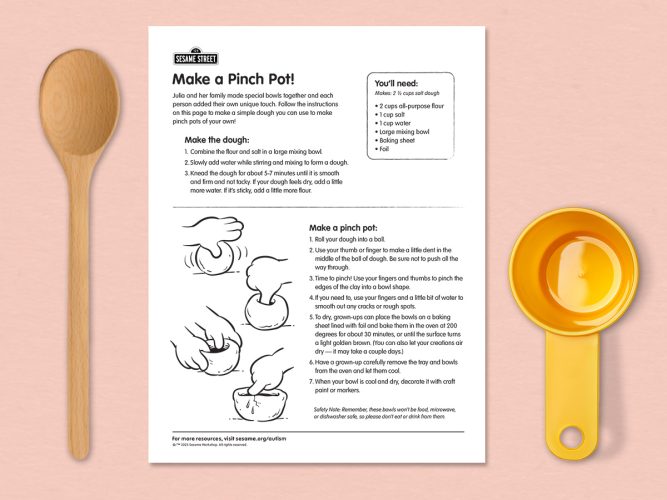
A Little Bit Different, A Little Bit the Same
A storybook on adjusting to small changes.
Written by Leslie Kimmelman, Illustrated by Marybeth Nelson
Flexibility can be a challenge for all children, but especially for children on the autism spectrum. Many autistic children also have an anxiety disorder, which is about more than lack of flexibility. Structure and routines help, and it’s also very important to “mix it up” sometimes so they can learn that routines may change… and that’s okay!
Julia is a friend on Sesame Street who is autistic. Share Julia’s story with children and notice how Julia’s visual schedule supported her throughout her day. Afterward, you might keep in mind these strategies for helping build children’s tolerance for change:
- Build little changes into the day, like Julia’s father did. Drive home a different route; change the seating arrangement around the family table, make small changes in the rules of a game, offer strawberry yogurt rather than banana; and so on.
- Display schedule cards with simple pictures to give visual clues about how the day will unfold. Review the cards in the morning and throughout the day: First we’re going to… next we’ll… then we’ll…
- Add new schedule cards. If children are comfortable with simple choices, you may sometimes incorporate a card with a question mark on it, along with the words “What would you like to do next?” Or, have a card which features your child’s picture, and the words “_____’s Choice.”
- Prepare children for the possibility of change—for instance, rain might make it necessary to change your plans! You might want to tape up two cards sometimes, so that you can say, for instance: “After lunch, we will check it it’s raining. We might be able to ride bikes, but if it rains, we might read a book instead.”
- Play with stretchy clay or dough to demonstrate what flexibility means.
- Make sure to offer praise when children show even the slightest bit of flexibility… it’s an effort that deserves to be noticed!
The storybook provides great strategies for caregivers and is an autism-friendly story that all children can enjoy.

Amazing to Me
When Julia and her family do a special art activity together, Julia finds a way to add her own amazing touch!

Make a Pinch Pot!
Simple craft instructions to help your family make pinch pots from homemade dough together.

Sharing Amazing
An adult-child coloring page to spark ideas and connection.

Super Helper
Finding ways to help their family can be a great way for autistic children to build skills and pursue goals. Download and share this autism-friendly coloring activity.

Autism and the Arts: A Conversation on Creativity and Community

Exploring the Amazing in Autistic Children: A Conversation with Camille Proctor, Founder of The Color of Autism Foundation
An article to help parents discover and support their autistic child’s unique perspective and personality

Creative, Talented, Amazing: A Conversation with Anna Wang, Co-founder of FCSN, about fostering autistic children’s talents
An article to help parents foster creative exploration and expression in their autistic child.
